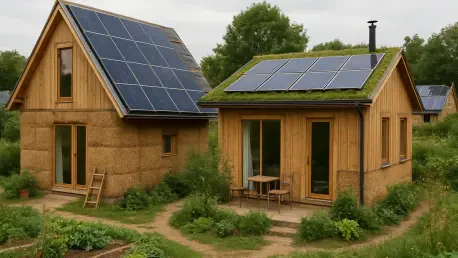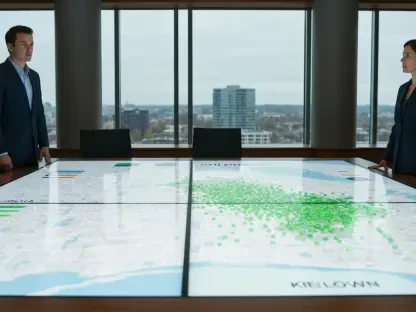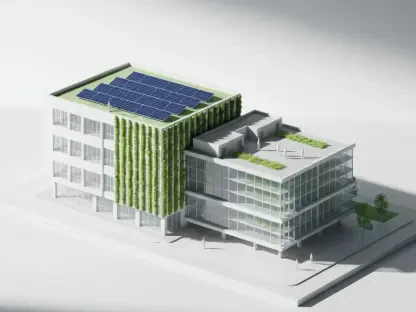Imagine a community where residents design their own homes, green spaces flourish amidst urban planning, and sustainability isn’t just a buzzword but a lived reality, taking shape in Oxfordshire, UK, at a pioneering residential project. This development has captured the attention of urban planners, environmentalists, and housing advocates alike as a unique experiment in blending self-build housing with market and affordable options, offering a glimpse into what future communities could look like. This roundup dives into diverse opinions, tips, and insights from industry leaders, community stakeholders, and planning experts to uncover what makes this project a potential model for sustainable living, highlighting both its innovative strides and the challenges it faces.
Unpacking the Vision: What Sets This Project Apart?
At the heart of this Oxfordshire development lies a commitment to redefining modern living through resident involvement and environmental focus. Industry observers note that the project’s emphasis on self-build plots, alongside traditional housing types, marks a significant departure from conventional development models. This approach not only empowers individuals to shape their living spaces but also fosters a sense of ownership rarely seen in large-scale projects. Many urban planners commend the hybrid planning framework, which combines broad principles with detailed specifics for immediate action, as a practical way to manage complexity.
Feedback from local stakeholders highlights the project’s responsiveness to housing demands while integrating community amenities like public spaces and care facilities. Some planning consultants argue that this balance of individual freedom and structured guidelines could inspire other regions to adopt similar strategies. However, there are concerns about whether such a personalized housing model can scale effectively without losing its unique charm or straining infrastructure, prompting a deeper look into its long-term viability.
Core Elements of a Sustainable Blueprint
Mixing Housing Options with Community Priorities
A key pillar of this development’s sustainability ethos is its diverse housing mix, encompassing self-build, market, and affordable units. Housing policy analysts praise this variety for addressing different socioeconomic needs, creating an inclusive environment that avoids the homogeneity often criticized in new developments. The inclusion of up to 1,329 dwellings, supported by amenities like a pub and allotments, is seen as a step toward building vibrant, self-sustaining neighborhoods, according to community development experts.
Yet, opinions differ on the challenges of maintaining design cohesion amidst such diversity. Some urban designers caution that allowing individual creativity in self-build plots risks a fragmented aesthetic if not carefully managed. Others suggest that with robust guidelines, this diversity can become a strength, reflecting real community character. The debate continues on how to ensure that such a model doesn’t prioritize individual expression over collective harmony.
Emphasizing Green Integration and Ecological Balance
Environmental advocates are particularly enthusiastic about the integration of extensive green spaces, including woodlands and pocket parks, into the masterplan. Sustainability consultants point out that features like rain gardens and attenuation basins not only manage water runoff but also enhance local biodiversity, aligning with broader ecological goals. These elements are often cited as tangible examples of how urban projects can contribute positively to their natural surroundings.
On the flip side, some ecologists express skepticism about the long-term maintenance of these green areas, warning that without dedicated funding and community involvement, such spaces could degrade over time. There’s also a concern that prioritizing visual appeal might overshadow deeper ecological impacts. Balancing these priorities remains a topic of active discussion among environmental planners, who stress the need for ongoing evaluation to ensure promises translate into results.
Redefining Urban Aesthetics with Flexible Guidelines
The updated design framework guiding this project has garnered attention for its role in shaping a cohesive yet dynamic community look. Urban design specialists appreciate how the code outlines specific street types and landmark points while allowing room for architectural variation, striking a balance between uniformity and creativity. This adaptability is seen as a forward-thinking trend in planning, potentially applicable to other sustainable initiatives.
Critics, however, question whether strict guidelines might inadvertently limit innovation, especially for self-build residents eager to push boundaries. Proponents counter that the framework actually encourages thoughtful experimentation within defined parameters, fostering a distinctive yet unified townscape. This tension between control and freedom continues to spark debate among designers and policymakers, who see the project as a testing ground for future urban codes.
Building Community Through Active Participation
Public engagement stands out as a cornerstone of this development’s approach, with extensive consultations shaping its direction. Community organizers highlight the value of involving residents, local authorities, and design panels in the planning process, noting that revisions like increased play areas and pedestrian zones reflect direct feedback. This participatory model is often contrasted with traditional top-down methods, earning praise for prioritizing resident voices.
Some planning experts, however, caution that sustained engagement is resource-intensive and may not always yield consensus, potentially slowing progress. Others argue that the human element introduced through such involvement adds depth to urban projects, making them more responsive to actual needs. The challenge lies in maintaining this dialogue over time, a point many stakeholders agree is crucial for the project’s lasting success.
Key Takeaways for Shaping Sustainable Communities
Drawing from varied perspectives, several lessons emerge on how this Oxfordshire project can inform broader sustainable development practices. Housing advocates emphasize the importance of integrating diverse living options to meet wide-ranging needs, a strategy that could be adapted elsewhere. Environmental experts underscore the necessity of embedding green initiatives into urban planning from the outset, ensuring they are not afterthoughts but core components.
Urban planners also advocate for hybrid planning strategies that allow flexibility while providing clear direction, a tactic seen as effective in managing large-scale projects. Additionally, the role of community input is repeatedly highlighted as vital for creating spaces that resonate with inhabitants. These insights collectively offer a roadmap for developers and policymakers aiming to balance growth with sustainability, encouraging a shift toward more inclusive and eco-conscious approaches.
Reflecting on a Trailblazing Effort
Looking back, the diverse opinions and insights gathered on this innovative housing project reveal a shared appreciation for its bold approach to sustainability and community design. The discussions underscore a consensus on the value of housing diversity, environmental integration, and resident engagement as foundational to meaningful urban progress. Differing views on scalability and design constraints provide a nuanced understanding of the hurdles faced, enriching the dialogue around sustainable living.
Moving forward, stakeholders and interested parties are encouraged to explore how these principles could be tailored to other regions, perhaps by initiating pilot projects or advocating for policy changes that support self-build and green-focused developments. Engaging with local planning councils to discuss hybrid frameworks or design codes could be a practical next step. This exploration not only honors the lessons learned but also paves the way for evolving housing solutions that prioritize both people and the planet.









